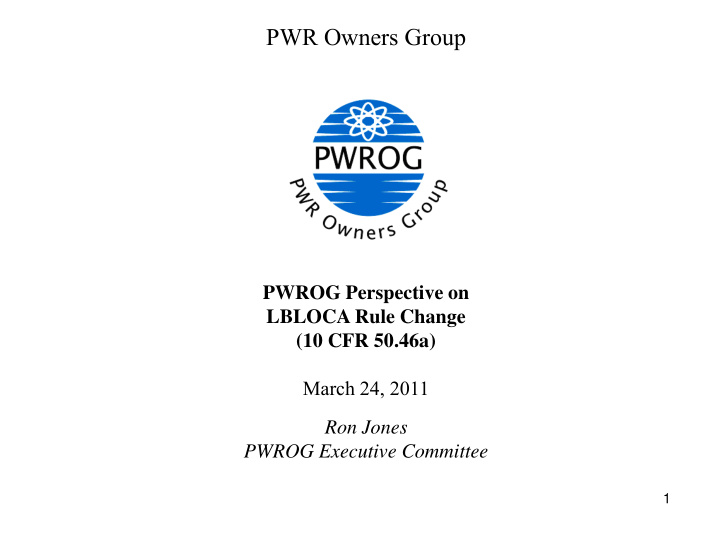



PWR Owners Group PWROG Perspective on LBLOCA Rule Change (10 CFR 50.46a) March 24, 2011 Ron Jones PWROG Executive Committee 1
PWR Owners Group LBLOCA Rule Change Introduction • PWROG supports a rule that meets the objectives stated in SECY 98-0300: – Enhance safety by focusing NRC and licensee resources in areas commensurate with their importance to health and safety. – Provide NRC with the framework to use risk information to take action in reactor regulatory matters. – Allow use of risk information to provide flexibility in plant operation and design, which can result in burden reduction without compromising safety • The current draft rule does not fully meet these objectives 2
PWR Owners Group KEY GAPS AND RECOMMENDATIONS OBJECTIVE GAP RECOMMENDATION Enhance safety by focusing NRC and Imposes a change control program focuses Use existing change control process, such as licensee resources in areas commensurate resources on non-risk-significant changes 10CFR50.59. with their importance to health and safety. Provide NRC with the framework to use Rule is not written so that it can clearly be Clarify rule language or guidance that the risk information to take action in reactor applied to GSI-191 with respect to debris reactor coolant system model may include regulatory matters. generation and transport. debris generation and transport. Allow use of risk information to provide • Rule has the potential to provide Use existing change control process. flexibility in plant operation and design, flexibility in operation and design. which can result in burden reduction • Change control program has potential to without compromising safety impose burden not commensurate with risk. 3
PWR Owners Group Alternate Transition Break Size For example, a frequency of 1 occurrence in 100,000 reactor years is an appropriate mean value for the LOCA frequency guideline for selecting the maximum design-basis LOCA since it is complemented by the requirement that appropriate mitigation capabilities, including effective severe accident mitigation strategies, must be retained for the beyond design-basis LOCA category. [SECY dated July 1, 2004] • Transition Break Size (TBS) has a mean frequency smaller than the SECY direction. • PWROG performed evaluation for members that supports smaller TBS • Revise wording for TBS to allow licensee to propose TBS. 4
PWR Owners Group LBLOCA Rule Change New design basis is not commensurate with the risk • Implementation for PWROG members will be burdensome and guidance is still largely undefined – At least 3 new analyses – New change control program – New monitoring programs – New restrictions – Others yet to be identified • New programs require more focus on non-risk-significant issues – Defeats part of the purpose of the rule • PWROG believes the rule can be simplified 5
PWR Owners Group LBLOCA Rule Change Recommended Next Steps • Changes to the rule and/or implementation guidance: – Provision for licensee to propose the Transition Break Size – Clarification or simplification of analyses required for “beyond design basis” – Clarification of model definition to allow for debris generation and transport • NRC and industry conduct transparent, public dialogue to define implementation requirements that are commensurate with risk from break larger than the TBS. 6
Recommend
More recommend